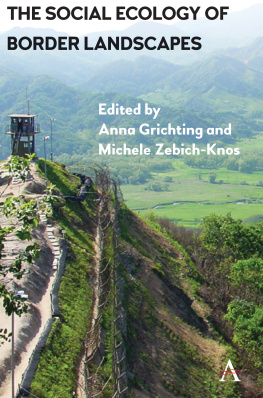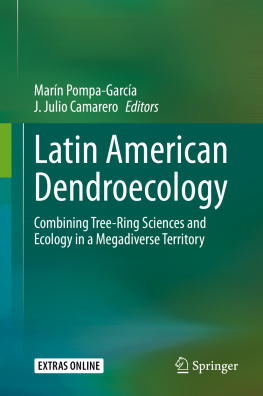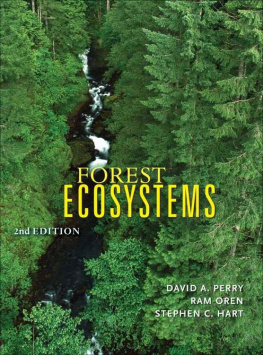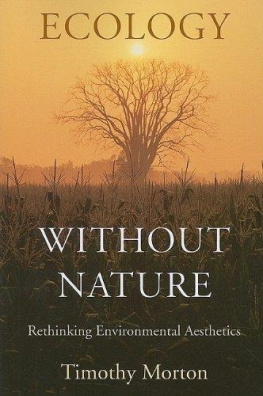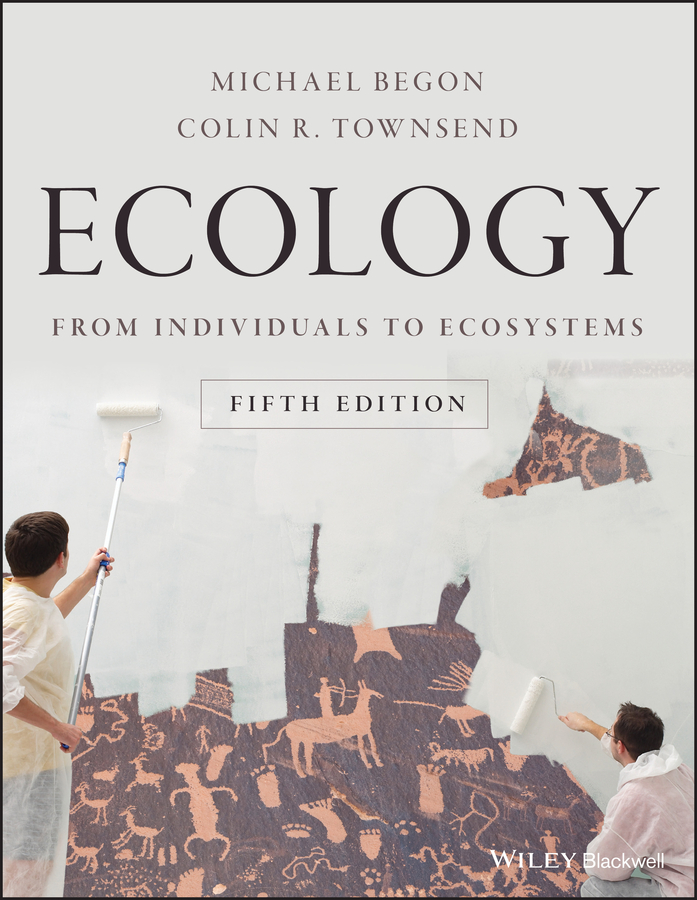
Table of Contents
List of Tables
- Chapter 1
- Chapter 4
- Chapter 8
- Chapter 10
- Chapter 11
- Chapter 13
- Chapter 14
- Chapter 15
- Chapter 18
- Chapter 19
- Chapter 20
- Chapter 21
- Chapter 22
List of Illustrations
- Chapter 1
- Chapter 2
- Chapter 3
- Chapter 4
- Chapter 5
- Chapter 6
- Chapter 7
- Chapter 8
- Chapter 9
- Chapter 10
- Chapter 11
- Chapter 12
- Chapter 13
- Chapter 14
- Chapter 15
- Chapter 16
- Chapter 17
- Chapter 18
- Chapter 19
- Chapter 20
- Chapter 21
- Chapter 22
Guide
Pages
ECOLOGY
From Individuals to Ecosystems
MICHAEL BEGON
University of Liverpool
Liverpool, UK
COLIN R. TOWNSEND
University of Otago
Dunedin, New Zealand
FIFTH EDITION

This fifth edition first published 2021 2021 by John Wiley & Sons Ltd
Edition History
4e, Wiley, 2006; 3e, Wiley, 1996; 2e, Wiley 1990; 1e, Wiley, 1986
All rights reserved. No part of this publication may be reproduced, stored in a retrieval system, or transmitted, in any form or by any means, electronic, mechanical, photocopying, recording or otherwise, except as permitted by law. Advice on how to obtain permission to reuse material from this title is available at http://www.wiley.com/go/permissions.
The right of Michael Begon and Colin R. Townsend to be identified as the authors of this work has been asserted in accordance with law.
Registered Offices
John Wiley & Sons, Inc., 111 River Street, Hoboken, NJ 07030, USA
John Wiley & Sons Ltd, The Atrium, Southern Gate, Chichester, West Sussex, PO19 8SQ, UK
Editorial Office
9600 Garsington Road, Oxford, OX4 2DQ, UK
For details of our global editorial offices, customer services, and more information about Wiley products visit us at www.wiley.com.
Wiley also publishes its books in a variety of electronic formats and by printondemand. Some content that appears in standard print versions of this book may not be available in other formats.
Limit of Liability/Disclaimer of Warranty
While the publisher and authors have used their best efforts in preparing this work, they make no representations or warranties with respect to the accuracy or completeness of the contents of this work and specifically disclaim all warranties, including without limitation any implied warranties of merchantability or fitness for a particular purpose. No warranty may be created or extended by sales representatives, written sales materials or promotional statements for this work. The fact that an organization, website, or product is referred to in this work as a citation and/or potential source of further information does not mean that the publisher and authors endorse the information or services the organization, website, or product may provide or recommendations it may make. This work is sold with the understanding that the publisher is not engaged in rendering professional services. The advice and strategies contained herein may not be suitable for your situation. You should consult with a specialist where appropriate. Further, readers should be aware that websites listed in this work may have changed or disappeared between when this work was written and when it is read. Neither the publisher nor authors shall be liable for any loss of profit or any other commercial damages, including but not limited to special, incidental, consequential, or other damages.
Library of Congress CataloginginPublication Data
Names: Begon, Michael, author. | Townsend, Colin R., author.
Title: Ecology : from individuals to ecosystems / Michael Begon, The University of Liverpool, Liverpool, UK, Colin Townsend, University of Otago, Dunedin, New Zealand.
Description: Fifth edition. | Hoboken, NJ : Wiley, 2021. | Includes bibliographical references and index.
Identifiers: LCCN 2020012775 (print) | LCCN 2020012776 (ebook) | ISBN 9781119279358 (paperback) | ISBN 9781119279372 (adobe pdf) | ISBN 9781119279310 (epub)
Subjects: LCSH: Ecology.
Classification: LCC QH541 .B415 2020 (print) | LCC QH541 (ebook) | DDC 577dc23
LC record available at https://lccn.loc.gov/2020012775
LC ebook record available at https://lccn.loc.gov/2020012776
Cover Design: Wiley
Cover Credit: Decorators painting wall Dougal Waters/Getty Images
Panel of Native American Newspaper Rock petroglyphs milehightraveler/Getty Image
This book is dedicated to our families, and especially to our children and grandchildren,
who will inherit the ecosystems we hand on to them
by Mike to Linda, Jessica, Robert, Carl, Ria and Erica,
and by Colin to Dominic, Brennan, Amelie and Ella
Preface
A science for everybody but not an easy science
This book is about the distribution and abundance of living organisms, and about the physical, chemical and especially the biological features and interactions that determine these distributions and abundances.
Unlike some other sciences, the subject matter of ecology is apparent to everybody: most people have observed and pondered the natural world. In this sense most people are ecologists of sorts. But ecology is not an easy science. It must deal explicitly with three separate levels of the biological hierarchy the individual organisms, the populations of organisms, and the communities of populations. Whats more, as we shall see, it cant ignore the detailed biology of individuals, or the pervading influences of historical, evolutionary and geological events. It feeds on advances in our knowledge of biochemistry, behaviour, climatology, plate tectonics and so on, but it feeds back to our understanding of vast areas of biology too. One of the fathers of modern evolutionary biology, T. H. Dobzhansky famously claimed, in the middle of the 20th century, that Nothing in biology makes sense, except in the light of evolution. But equally, very little in evolution, and hence in biology as a whole, makes sense, except in the light of ecology.
Ecology, too, has the distinction of being peculiarly confronted with uniqueness: millions of different species, countless billions of genetically distinct individuals, all living and interacting in a varied and everchanging world. Imagine doing chemistry if water molecules were not precisely the same, always and everywhere or physics if the speed of light was different at different field sites. The challenge for ecologists, therefore, is to seek patterns and predictions in a way that recognises this uniqueness and complexity, rather than being swamped by it. The mathematician and philosopher Alfred North Whiteheads advice for scientists, offered 100 years ago, is never more apposite than when applied to ecology: Seek simplicity and distrust it.
Thirtyfour years on: the urgent problems facing us
This fifth edition comes fully 14 years after its immediate predecessor and 34 years after the first edition. Much has changed over that time in ecology, in the world around us, and also, unsurprisingly, in us authors. The first edition had a cave painting as its cover, which we justified in the Preface by arguing that ecology, if not the oldest profession, is probably the oldest science, since the most primitive humans had to understand, as a matter of necessity, the dynamics of the environment in which they lived. We pursued that cave painting theme for two further editions, but for the fourth edition, replaced it with its modern equivalent, urban graffiti. This captured the idea that we, as a species, are still driven to broadcast our feelings graphically and publicly, but the cave paintings celebration of natures bounty had been replaced by an impassioned plea for its protection. Now, 14 years on, the image on our cover, and its message, are darker and more desperate. Instead of focusing on those who are pleading, on natures behalf, for respect, this time we shine our light on man the destroyer obliterating the heritage in our cave painting as he is threatening our natural heritage (the inspiration coming from graffiti artist Banksy, who used a similar idea in an art work involving a water blaster). The ecosystem on our front cover is still there but it is disappearing.
Next page


